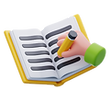Curriculum for Primary Level
(Level 1 to 3)

At the primary level, we cultivate a profound mastery of the English language, guiding students beyond surface-level learning.
Our curriculum delves into not only reading and writing but also the deeper mechanics of language.
Students are encouraged to analyze language choices, understanding how texts create mood and tone through literary techniques.
With a focus on phonics and eloquent expression, we empower students to become confident, articulate speakers from an early age.
Level Guide
BrightThinkers Academy structures lessons from Level 1 to 5 by combining two age groups per level, allowing students to learn at a faster pace.
This approach challenges them appropriately, fostering growth and confidence as they progress through more complex tasks.
Levels 1 to 3 are designed for Primary school students aged 7 to 12, while Levels 4 and 5 cater to Secondary school students aged 13 to 17.
Level 1
Ages 7 & 8
Primary 1 & 2
Year 2 & 3
Level 2
Ages 9 & 10
Primary 3 & 4
Year 4 & 5
Level 3
Ages 11 & 12
Primary 5 & 6
Year 6 & 7
Level 4
Ages 13 & 14
Secondary 1 & 2
Year 8 & 9
Level 5
Ages 15 to 17
Secondary 3 to 5
Year 10 to 12
Students are placed into levels based on diagnostic tests, with advice for their placement.
Each level typically takes 1 to 2 years to complete, but students can progress faster through diagnostic assessments if needed.
There are no levels for Private 1-1 classes as classes will be specially tailored to the student's pace and needs.
Syllabus for Primary Level
(Level 1 to 3)
At BrightThinkers Academy, our curriculum is built around five essential components.
These components are designed to develop students into confident readers, fluent speakers, strong writers, and critical thinkers with a broad understanding of the world.
.png)
.png)
.png)
.png)
.png)
Reading, Listening & Oral
Language Mastery
Creative Writing
General Knowledge
Mock Exam
.png)
Reading,
Listening & Oral
Summary:
Train students to critically analyze texts, comprehend spoken language with nuance, and develop confident, eloquent speaking skills.
-
Phonics and Decoding:
Strengthen students' ability to decode words accurately and read fluently with proper pronunciation.
-
Text Analysis:
Learn how literary devices (e.g., similes, metaphors) and language choices create different tones, moods, and emotional effects in texts.
-
Comprehension:
Develop critical skills to assess how language influences meaning, emotional impact, and overall communication.
-
Recognizing Genres:
Understand how different genres (e.g., narrative, expository) use language features distinctively to achieve their purpose.




